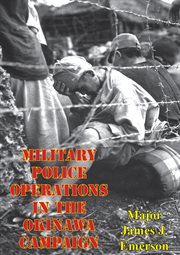Nonfiction
eBook
Details
PUBLISHED
DESCRIPTION
1 online resource
ISBN/ISSN
LANGUAGE
NOTES
During the World War II campaign to seize the island of Okinawa, Operation Iceberg, U.S. Tenth Army employed a significant U.S. Army and U.S. Marine Corps military police structure. However, the challenges posed to these units by military traffic, nearly 300,000 enemy civilians, and over 10,000 prisoners of war are issues largely neglected by historians. This study analyzes the overall effectiveness and value of the largest joint military police operation in the Pacific theater. It evaluates military police force structure and operations by assessing pre-campaign planning and results of operations with extant historical doctrine, operational setting, and historical information. Historical military police doctrine is discussed to identify standards which existed in 1945. Intelligence or other information about the operational environment is examined for relevance to doctrine. Finally, historical accounts or information about military police operations are contrasted with doctrine and operational setting. Historical information is assessed within five mission areas; traffic control operations, prisoner of war operations, civilian handling operations, security operations, and law and order operations. Within these mission areas information is further organized by unit, time, and relation to the tactical situation. Detailed assessment and evaluation reveal Tenth Array military police overall effectiveness and value in Operation Iceberg
Mode of access: World Wide Web







